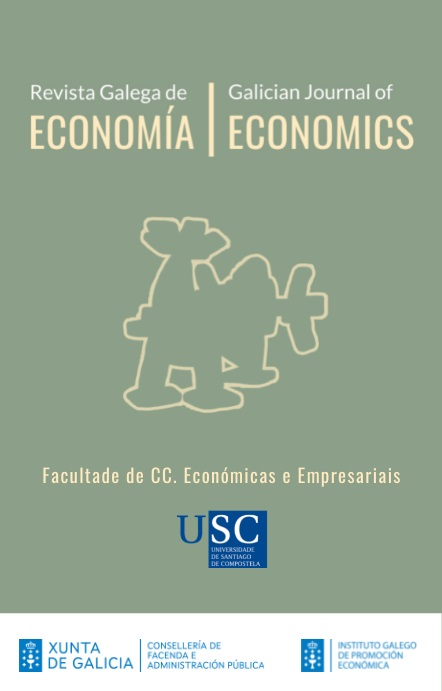THE EFFECT OF BANK RESTRUCTURING ON THE ISSUANCE OF PREFERRED SHARES IN SPAIN
Contido principal do artigo
Resumo
crisis. During this period, the Spanish financial system has experienced a process of
economic imbalance and downturn as a consequence of massive exposure to the
construction sector. In this context, the banking institutions, aware of the need to
recapitalize their balance sheets, offered their retail clients a complex and high-risk
product: preferred shares. What at first was considered the ideal solution for
recapitalizing the institutions has done nothing but worsen the economic situation,
highlighting the vulnerability of the banking Spanish system. All of this gave rise to a
process of bank restructuring that was unprecedented in Spain. The result has been the
reduction of the number of banking institutions from 45 in 2009 to 12 today, with the
consequent repercussions on the macroeconomic variables and the economies of families
and businesses.
Palavras-chave:
Detalles do artigo
Referências
ASPE, P. (2009). Los Orígenes de la Crisis. Este país, 215, pp. 8-12.
ELORRIAGA, E. R. (2010). Las nuevas medidas de Basilea III en materia de capital. Estabilidad financiera, 19, pp. 9-20.
FERNÁNDEZ, P. L., and PÉREZ, M. (2013). Las participaciones preferentes. La génesis del corralito español. Estrategia Financiera, 303, pp. 18-35.
FRANCIA, L. (2011): Salgado convoca una rueda de prensa para detallar las medidas para reforzar lascajas// http://www.rtve.es/noticias/20110124/salgadoconvoca-una-rueda-prensa-para-detallar-las-medidas-para-reforzar-lascajas/397817.shtml
GARCÍA, C. V. and CRUZ, S. (2012). Participaciones preferentes: un análisis desde la perspectiva del partícipe. Análisis Financiero, 120, pp. 6-17.
GONZÁLES, J. and HITA, E. (2012) El Gobierno crea el 'banco malo' que absorberá activos 'no tan malos' en un horizonte de hasta 15 años// http://www.elmundo.es/elmundo/2012/08/31/economia/1346413149.html.
JAREÑO, F. and TOLENTINO, M. (2012). A brief review of the US financial crisis origin. American Journal of Scientific Research, 74, pp. 51-57.
MARTÍN, P. (2012). ¿Interesa acudir al canje de preferentes por acciones de Sabadell y Santander? , Cinco Días.// http://cincodias.com/cincodias/2011/12/13/merca.
MARTÍN, P. and ABRIL, I. (2012). Las claves del canje de preferentes de Bankia. Cinco Días.// http://cincodias.com/cincodias/2012/03/20/mercados/1332462414_850215.html.
MARTÍNEZ, J. M. (2012). Las participaciones preferentes: ascenso, auge y declive. Cuadernos de información económica, 231, pp. 87-100.
MAUDOS, J. (2009). La Banca Española ante la Crisis Financiera. Clm.Economía, 14, pp. 31-54.
MERCADO AIAF DE RENTA FIJA (2009). Revista de finanzas y Banca. Instituto superior de técnicas y revistasbancarias.// http://www.finanzasybanca.com/iberfinanzas/index.php/M/mercado-AIAF-de-RentaFija.html.
OJEDA, A. and JAREÑO, F. (2013). Los efectos de la crisis económica en el sistema financiero español, Estudios Financieros. Revista de Contabilidad y Tributación, 360, pp. 261-276.
PÉREZ, P. (2012). Cómo salir del callejón de las participaciones preferentes, Inversión y Finanzas.com.// http://www.finanzas.com/noticias/economia/2012-02-13/655929_como-salir-callejonparticipaciones-preferentes.html.
POPULAR, B. (2012). Banco Popular culmina con éxito su oferta de recompra y canje de participaciones preferentes por bonos convertibles en acciones, El Economista.es. //http://www.eleconomista.es/empresas-finanzas/noticias/3872181/04/12/BancoPopular-culmina-con-exito-su-oferta-de-recompra-y-canje-de-participaciones-preferentespor-bonos-convertibles-en-acciones.html#.Kku8EnoFenCfZbT.
ROMANI, M. (2012). La consolidación de la banca española: de 50 a 12 entidades en tres años y bajando, Diario Expansión. // http://www.expansion.com/2012/06/18/empresas/banca/1340020056.html Artículo Expansión.
SANTIAGO, S., MANZANO, D., ONTIVEROS, E. and VALERO, F. J. (2009). Rescates y reestructuración bancaria: el caso español, Working Paper 152/2009.
SEVILLANO, J. M., and SANCHÍS, A. (2010). Los instrumentos híbridos en los recursos propios de las entidades financieras: naturaleza y cambios tras la crisis financiera. Estabilidad Financiera, 215, pp. 55-72.
ORTEGA, R. (coord.) (2011). Mecanismos de gestión y prevención de futuras crisis financieras. Madrid: Fundación de Estudios Financieros.
VALVERDE, S. C. and MAUDOS, J. (2010). Diez interrogantes del sistema bancario español. Cuadernos de información económica, 215, pp. 89-105.






